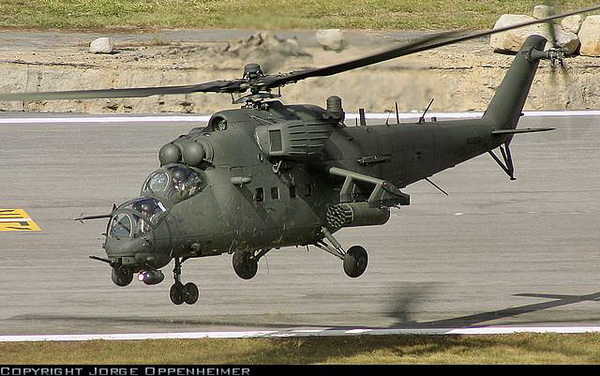MIL MI-35 Hind
The Mil Mi-24 (NATO reporting name "Hind") is a large helicopter gunship (and attack helicopter) and low-capacity troop transport (Carries 8) produced by Mil Moscow Helicopter Plant and operated from 1972 by the Soviet Air Force, its successors, and over thirty other nations. In October 2007, the Russian Air Force announced it would replace its 250 Mi-24 helicopter gunships with 300 more modern Mi-28s and possibly Ka-50s by 2015.
In NATO circles the export versions, Mi-25 and Mi-35, are simply denoted with a letter suffix as "Hind D" and "Hind E" respectively. Soviet pilots called the aircraft letayushchiy tank, “flying tank”. More common unofficial nicknames were (Krokodil, “Crocodile”), due to the helicopter's new camouflage scheme and (Stakan, “Glass”), because of the flat glass plates which surround the three place cockpit of the Mi-24A.
National origin Soviet Union
Manufacturer Mil
First flight September 19, 1969
Introduced 1972
Status Active
Primary users
Russian Air Force
ca. 50 other users
Number built 2,000 (estimated)
Developed from Mil Mi-8
Developed into Mil Mi-28
Design
The core of the aircraft was derived from the Mil Mi-8 (NATO reporting name "Hip"): two top-mounted turboshaft engines driving a mid-mounted 17.3 m five-blade main rotor and a three-blade tail rotor. The engine configuration gave the aircraft its distinctive double air intake. Original versions have an angular greenhouse-style cockpit; Model D and later have a characteristic tandem cockpit with a "double bubble" canopy. Other airframe components came from the Mi-14 "Haze". Two mid-mounted stub wings provide weapon hardpoints, each offering three stations, in addition to providing lift. The load-out mix is mission dependent; Mi-24s can be tasked with close air support, anti-tank operations, or aerial combat.
The body is heavily armored and can resist impacts from .50 caliber (12.7 mm) rounds from all angles, including the titanium rotor blades. The cockpit is an even more heavily armored titanium tub and can resist impact from 37mm cannon rounds. The cockpit and crew compartment are overpressurized to protect the crew in NBC conditions. Considerable attention was given to making the Mi-24 fast. The airframe was streamlined, and fitted with retractable tricycle undercarriage landing gear to reduce drag. The wings provide considerable lift at high speed, up to a quarter of total lift. The main rotor was tilted 2.5° to the right from the fuselage to counteract dissymmetry of lift at high speed and provide a more stable firing platform. The landing gear was also tilted to the left so the rotor would still be level when the aircraft was on the ground, making the rest of the airframe tilt to the left. The tail was also asymmetrical to give a side force at speed, thus unloading the tail rotor.
Considerable attention was given to making the Mi-24 fast. The airframe was streamlined, and fitted with retractable tricycle undercarriage landing gear to reduce drag. The wings provide considerable lift at high speed, up to a quarter of total lift. The main rotor was tilted 2.5° to the right from the fuselage to counteract dissymmetry of lift at high speed and provide a more stable firing platform. The landing gear was also tilted to the left so the rotor would still be level when the aircraft was on the ground, making the rest of the airframe tilt to the left. The tail was also asymmetrical to give a side force at speed, thus unloading the tail rotor.
A modified Mi-24B, named A-10, was used in several speed and time to climb world record attempts. The helicopter had been modified to reduce weight as much as possible, and among the measures used was to remove the stub wings. The speed record over a closed 1000 km course set on August 13, 1975 of 332.65 km/h still stands, as does many of the female specific records set by the all female crew of Galina Rastorgoueva and Ludmila Polyanskaia. On 21 September 1978 the A-10 set the absolute speed record for helicopters with 368.4 km/h over a 15/25 km course. The record stood until 1986 when it was broken by the current record holder, a modified Westland Lynx.
General characteristics
Crew: 2-3: pilot, weapons system officer and technician (optional)
Capacity: 8 troops or 4 stretchers
Length: 17.5 m (57 ft 4 in)
Rotor diameter: 17.3 m (56 ft 7 in)
Wingspan: 6.5 m (21 ft 3 in)
Height: 6.5 m (21 ft 3 in)
Disc area: 235 m² (2,530 ft²)
Empty weight: 8,500 kg (18,740 lb)
Max takeoff weight: 12,000 kg (26,500 lb)
Powerplant: 2× Isotov TV3-117 turbines, 1,600 kW (2,200 hp) each
Performance
Maximum speed: 335 km/h (208 mph)
Range: 450 km (280 miles)
Service ceiling: 4,500 m (14,750 ft)
Armament
Internal guns
flexible 12.7 mm Yakushev-Borzov Yak-B Gatling gun on most variants. Maximum of 1,470 rounds of ammunition.
fixed twin-barrel GSh-30K on the Mi-24P. 750 rounds of ammunition.
flexible twin-barrel GSh-23L on the Mi-24VP and Mi-24VM. 450 rounds of ammunition.
PKT passenger compartment window mounted machine guns
External stores
Total payload is 1,500 kg of external stores.
Inner hardpoints can carry at least 500 kg
Outer hardpoints can carry up to 250 kg
Wing-tip pylons can only carry the 9M17 Phalanga (in the Mi-24A-D) or the 9K114 Shturm complex (in the Mi-24V-F).
Bomb-load
Bombs within weight range (presumably ZAB, FAB, RBK, ODAB etc.), Up to 500 kg.
MBD multiple ejector racks (presumably MBD-4 with 4xFAB-100)
KGMU2V submunition/mine dispenser pods
First-generation armament (standard production Mi-24D)
GUV-8700 gunpod (with a 12.7 mm Yak-B + 2x7.62 mm GShG-7.62 mm combination or one 30 mm AGS-17)
UB-32 S-5 rocket launchers
S-24 240 mm rocket
9M17 Phalanga (a pair on each wingtip pylon)
Second-generation armament (Mi-24V, Mi-24P and most upgraded Mi-24D)
UPK-23-250 gunpod carrying the GSh-23L
B-8V20 a lightweight long tubed helicopter version of the S-8 rocket launcher
9K114 Shturm in pairs on the outer and wingtip pylons.

